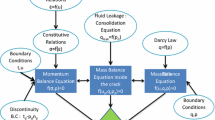Abstract
Anisotropic rock mass is often encountered in rock engineering, and cannot be simplified as an isotropic problem in numerical models. A good understanding of rock fracturing processes and the ability to predict fracture initiation and propagation in anisotropic rock masses are required for many rock engineering problems. This paper describes the development of the anisotropic function in FRACOD—a specialized fracture propagation modelling software—and its recent applications to rock engineering issues. Rock anisotropy includes strength anisotropy and modulus anisotropy. The level of complexity in developing the anisotropic function for strength anisotropy and modulus anisotropy in FRACOD is significantly different. The strength anisotropy function alone does not require any alteration in the way that FRACOD calculates rock stress and displacement, and therefore is relatively straightforward. The modulus anisotropy function, on the other hand, requires modification of the fundamental equations of stress and displacement in FRACOD, a boundary element code, and hence is more complex and difficult. In actual rock engineering, the strength anisotropy is often considered to be more pronounced and important than the modulus anisotropy, and dominates the stability and failure pattern of the rock mass. The modulus anisotropy will not be considered in this study. This paper discusses work related to the development of the strength anisotropy in FRACOD. The anisotropy function has been tested using numerical examples. The predicted failure surfaces are mostly along the weakest planes. Predictive modelling of the Posiva’s Olkiluoto Spalling Experiment was made. The model suggests that spalling is very sensitive to the direction of anisotropy. Recent observations from the in situ experiment showed that shear fractures rather than tensile fractures occur in the holes. According to the simulation, the maximum tensile stress is well below the tensile strength, but the maximum shear stress is probably enough to displace mica contact.













Similar content being viewed by others
Abbreviations
- D s, D n :
-
Shear and normal components of displacement discontinuity
- D js , D jn :
-
Displacement discontinuities of element j
- A ss, A sn, A ns, A nn :
-
Boundary influence coefficients for stresses
- B ss, B sn, B ns, B nn :
-
Boundary influence coefficients for displacements
- σ js,0 , σ jn,0 :
-
Shear and normal stresses on element j contributed by the far-field stresses
- σ is , σ in :
-
Shear and normal stresses on element i
- K s, K n :
-
Shear and normal fracture stiffnesses
- G :
-
Total strain energy release rate G at a crack tip
- G I, G II :
-
Strain energy release rate in mode I and mode II
- W :
-
Strain energy
- a i :
-
Length of element i
- θ :
-
Direction angle
- σ 1, σ 2, σ 3 :
-
Major, intermediate and minor principal stresses
- σ s, σ n :
-
Shear and normal stresses on a plane
- σ x , σ y :
-
Stress components in x-direction and y-direction
- σ t :
-
Tensile strength of intact rock
- ϕ i :
-
Rock internal friction angle
- c :
-
Cohesion
- β :
-
Orientation angle of a potential failure plane
- S :
-
Shear strength of a plane
- F s :
-
Shear failure indicator of a plane
- F t :
-
Tensile failure indicator of a plane
- K I, K II :
-
Mode I and mode II stress intensity factor
- K IC, K IIC :
-
Mode I and mode II fracture toughness
- E :
-
Young’s modulus
- ν :
-
Poisson’s ratio
References
Crouch SL (1976) Solution of plane elasticity problems by the displacement discontinuity method. Int J Numer Methods Eng 10:301–343
Crouch SL, Starfield AM (1983) Boundary element methods in solid mechanics. George Allen & Unwin, Australia
Hakala M, Kuula H, Hudson JA (2005) Strength and strain anisotropy of Olkiluoto mica gneiss. Working report 2005, 61, Olkiluoto, Finland, Posiva Oy, pp 57–58
Hudson JA, Harrison JP (1997) Engineering rock mechanics—an introduction to the principles. Pergamon, NY, p 144
Jing L (2003) A review of techniques, advances and outstanding issues in numerical modelling for rock mechanics and rock engineering. Int J Rock Mech Min Sci 40:283–353
Kemppainen K, Hakala M, Johansson E, Kuula H, Hudson JA (2011) In-situ rock stress-strength comparison: Posiva’s Olkiluoto Spalling Experiment (POSE). In: Qian Q, Zhou Y (eds) Harmonising rock engineering and the environment, 12th ISRM international congress on rock mechanics, Beijing, pp 434–435
Martin CD, Christiansson R (2009) Estimating the potential for spalling around a deep nuclear waste repository in crystalline rock. Int J Rock Mech Min Sci 46:219–228
Shen B, Stephansson O (1993) Modification of the G-criterion of crack propagation in compression. Int J Eng Fract Mech 47(2):177–189
Shen B, Stephansson O, Rinne M (2013) Modelling rock fracturing processes: a fracture mechanics approach using FRACOD. Springer, Berlin, 173 p, ISBN 978-94-007-6903
Siren T (2012) Fracture toughness properties of rocks in Olkiluoto: laboratory measurements 2008–2009. Working Report 2012-25, Posiva Oy
Siren T, Shen B, Rinne M, Kemppainen K (2011) Numerical anisotropic fracture mechanics modelling in crystalline rock. In: Qian Q, Zhou Y (eds) Harmonising rock engineering and the environment, 12th ISRM international congress on rock mechanics, Beijing, pp 276–277
Valli J, Hakala M, Wanne T, Kantia P, Siren T (2014) ONKALO POSE experiment—phase 3: execution and monitoring. Working report 2013–2014, Posiva
Author information
Authors and Affiliations
Corresponding author
Rights and permissions
About this article
Cite this article
Shen, B., Siren, T. & Rinne, M. Modelling Fracture Propagation in Anisotropic Rock Mass. Rock Mech Rock Eng 48, 1067–1081 (2015). https://doi.org/10.1007/s00603-014-0621-x
Received:
Accepted:
Published:
Issue Date:
DOI: https://doi.org/10.1007/s00603-014-0621-x




